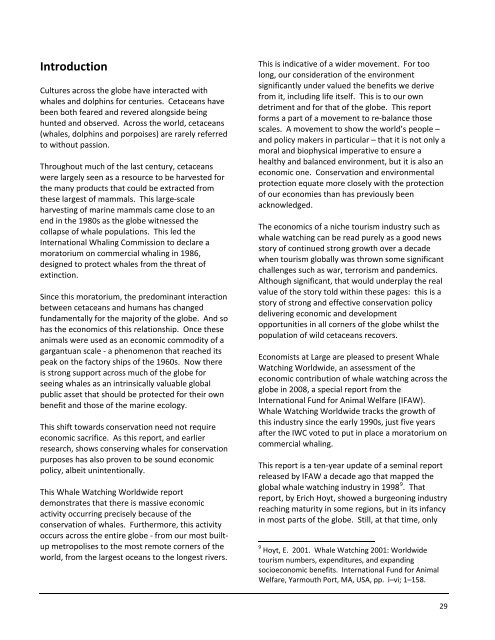Whale Watching Worldwide
Whale Watching Worldwide
Whale Watching Worldwide
Create successful ePaper yourself
Turn your PDF publications into a flip-book with our unique Google optimized e-Paper software.
Introduction<br />
Cultures across the globe have interacted with<br />
whales and dolphins for centuries. Cetaceans have<br />
been both feared and revered alongside being<br />
hunted and observed. Across the world, cetaceans<br />
(whales, dolphins and porpoises) are rarely referred<br />
to without passion.<br />
Throughout much of the last century, cetaceans<br />
were largely seen as a resource to be harvested for<br />
the many products that could be extracted from<br />
these largest of mammals. This large‐scale<br />
harvesting of marine mammals came close to an<br />
end in the 1980s as the globe witnessed the<br />
collapse of whale populations. This led the<br />
International Whaling Commission to declare a<br />
moratorium on commercial whaling in 1986,<br />
designed to protect whales from the threat of<br />
extinction.<br />
Since this moratorium, the predominant interaction<br />
between cetaceans and humans has changed<br />
fundamentally for the majority of the globe. And so<br />
has the economics of this relationship. Once these<br />
animals were used as an economic commodity of a<br />
gargantuan scale ‐ a phenomenon that reached its<br />
peak on the factory ships of the 1960s. Now there<br />
is strong support across much of the globe for<br />
seeing whales as an intrinsically valuable global<br />
public asset that should be protected for their own<br />
benefit and those of the marine ecology.<br />
This shift towards conservation need not require<br />
economic sacrifice. As this report, and earlier<br />
research, shows conserving whales for conservation<br />
purposes has also proven to be sound economic<br />
policy, albeit unintentionally.<br />
This <strong>Whale</strong> <strong>Watching</strong> <strong>Worldwide</strong> report<br />
demonstrates that there is massive economic<br />
activity occurring precisely because of the<br />
conservation of whales. Furthermore, this activity<br />
occurs across the entire globe ‐ from our most built‐<br />
up metropolises to the most remote corners of the<br />
world, from the largest oceans to the longest rivers.<br />
This is indicative of a wider movement. For too<br />
long, our consideration of the environment<br />
significantly under valued the benefits we derive<br />
from it, including life itself. This is to our own<br />
detriment and for that of the globe. This report<br />
forms a part of a movement to re‐balance those<br />
scales. A movement to show the world’s people –<br />
and policy makers in particular – that it is not only a<br />
moral and biophysical imperative to ensure a<br />
healthy and balanced environment, but it is also an<br />
economic one. Conservation and environmental<br />
protection equate more closely with the protection<br />
of our economies than has previously been<br />
acknowledged.<br />
The economics of a niche tourism industry such as<br />
whale watching can be read purely as a good news<br />
story of continued strong growth over a decade<br />
when tourism globally was thrown some significant<br />
challenges such as war, terrorism and pandemics.<br />
Although significant, that would underplay the real<br />
value of the story told within these pages: this is a<br />
story of strong and effective conservation policy<br />
delivering economic and development<br />
opportunities in all corners of the globe whilst the<br />
population of wild cetaceans recovers.<br />
Economists at Large are pleased to present <strong>Whale</strong><br />
<strong>Watching</strong> <strong>Worldwide</strong>, an assessment of the<br />
economic contribution of whale watching across the<br />
globe in 2008, a special report from the<br />
International Fund for Animal Welfare (IFAW).<br />
<strong>Whale</strong> <strong>Watching</strong> <strong>Worldwide</strong> tracks the growth of<br />
this industry since the early 1990s, just five years<br />
after the IWC voted to put in place a moratorium on<br />
commercial whaling.<br />
This report is a ten‐year update of a seminal report<br />
released by IFAW a decade ago that mapped the<br />
global whale watching industry in 1998 9 . That<br />
report, by Erich Hoyt, showed a burgeoning industry<br />
reaching maturity in some regions, but in its infancy<br />
in most parts of the globe. Still, at that time, only<br />
9 Hoyt, E. 2001. <strong>Whale</strong> <strong>Watching</strong> 2001: <strong>Worldwide</strong><br />
tourism numbers, expenditures, and expanding<br />
socioeconomic benefits. International Fund for Animal<br />
Welfare, Yarmouth Port, MA, USA, pp. i–vi; 1–158.<br />
29

















